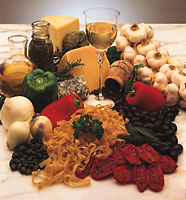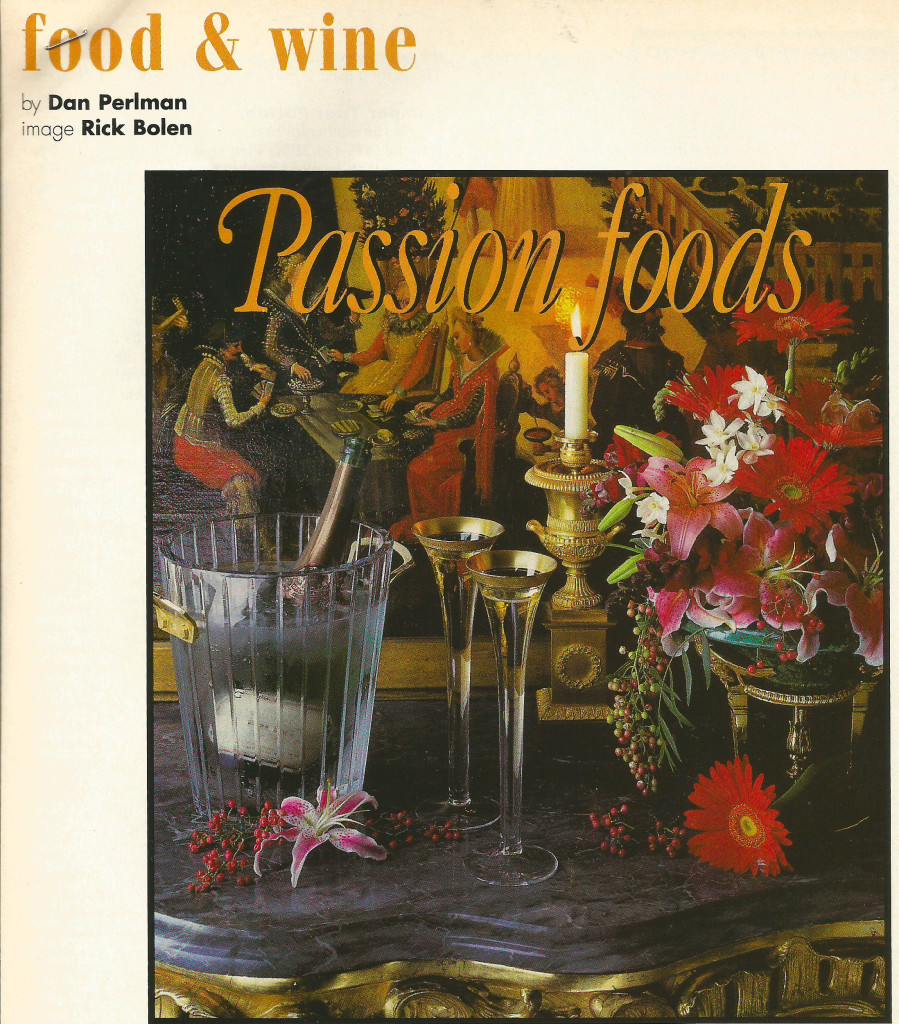Eat Drink Camera Action!
May 1997
Pages 42-43
Camera
 While I’m sure that with some effort I, or any of you, could come up with a film that does not include some form of eating or drinking, I am, for the moment, at a loss to come up with one. Edibles and inebriates are more a part of our on-screen entertainment than are sex and violence. Has anyone done a study on the deleterious effects on our nation’s youth?
While I’m sure that with some effort I, or any of you, could come up with a film that does not include some form of eating or drinking, I am, for the moment, at a loss to come up with one. Edibles and inebriates are more a part of our on-screen entertainment than are sex and violence. Has anyone done a study on the deleterious effects on our nation’s youth?
Of course, food and drink, especially wine, have their place in the world of the erotic as we have chatted about in past columns. Two of the most erotic scenes (one gay, one straight) I’ve seen on film both involve ingestibles: the champagne-sex vignette in My Beautiful Launderette and the egg yolk-orgasm clip (trust me, you have to see it) in Tampopo.
What we eat and drink has even been at the heart of some of the most fun (in my humble opinion) films out there. Babette’s Feast would have been an exceedingly tedious and long film about a lonely woman in the middle of nowhere doing nothing, were it not for the feast in question. Instead we have a slow build that involves much poking and prodding of foodstuffs, simmering, sizzling and just generally heating up of dishes, and a long, caressing, idyllic repast that makes the whole lengthy process worthwhile.
Night of the Comet manages to create an entire dramatic saga of sex and romance, danger and violence, while all the while, propping the whole thing up, is a single, solitary, bottle of rare wine. Try finding a film of the “black-and-white era” that doesn’t involve champagne at some point or another, starting right back with the first Academy Award-winning film, Wings, a silent film that includes an entire champagne seduction scene with bubbly special effects.
Not so long ago, Like Water For Chocolate splashed across our screens with a series of sensuous recipes that intertwined with the characters’ lives as they grew from small children to adults. Dishes that created flaming passion mingled with plates of sorrow and joy. Whether it was holiday peppers stuffed with meat and walnuts, a plate of molé, or even the now famed quail with rose petal sauce, we even got instructions on how to make them.
One of my favorites, even apart from that incredible egg yolk scene, is the Japanese film Tampopo. First, it’s just plain fun. One part “spaghetti western” (see, we even use food terms for film styles), one part “Kung Fu,” and all parts spoof, this film is the search for the holy grail – in the form of the perfect bowl of noodle soup. Exalted beyond, well, beyond anything a bowl of noodle soup probably ever rated, we learn about everything from proper water temperature, to the making of good soup stock, to the right way to knead your noodle…so to speak.
And on that note, I’ve decided to offer you my own version. It will not be as decorative as a bowl of noodle soup from your favorite noodle shop. It will not even be particularly Japanese in character. Think of it as a nice Jewish boy from the Midwest meets Tokyo… somewhere.
My Noodle Soup
Roasted vegetable stock:
2 yellow onions
2 carrots
2 stalks of celery
2 red bell peppers
2 parsnips
1 turnip
1 rutabaga
2 heads of garlic
2 bay leaves
2 teaspoons black peppercorns
2 pieces star anise
1 small piece ginger root
1 cinnamon stick
1/4 cup olive oil
5-6 quarts of cold water
Wash but do not peel vegetables. Cut all vegetables in half and put in a roasting pan with the spices. Toss with the oil. Roast in a 350 F oven for 45 minutes, flipping them around occasionally. They should be softened and somewhat browned – don’t let them burn. Put all the roasted veggies into a large stockpot and cover with water by 1 inch. Heat over medium heat until the water just starts to simmer -you don’t want a real full boil. Reduce the heat to the minimum setting you can get away with and let the stock infuse at least 6 hours. I generally let mine go for close to 24 hours. Strain the stock and discard the solids. You should end up with about 3 quarts of stock.
The noodles, et al:
Soba noodles (buckwheat)
4 egg yolks
2 scallions, thinly sliced
Light soy sauce
Pinch of saffron threads
For noodle soup, I tend to like simplicity. If you like it more elaborate, you can add additional things like little slices or shreds of roasted meats, sliced and lightly cooked vegetables, or whatever your heart desires. If you don’t like the buckwheat noodles, substitute whatever kind of noodles are your favorite. Bring some water to a boil and cook the noodles until “al dente,” soft but still just a touch firm. Meanwhile, reheat the soup stock just to the point it starts to boil. Place noodles in bowls. Pour stock over each just to cover. Top with chopped scallions. Carefully float an egg yolk in each bowl on top of the noodles. Garnish with 3-4 saffron threads per bowl. Serve with soy sauce on the side and let each guest season to taste. This should be just about right for four servings. Slurp to your heart’s content.
Q San Francisco magazine premiered in late 1995 as a ultra-slick, ultra-hip gay lifestyle magazine targeted primarily for the San Francisco community. It was launched by my friends Don Tuthill and Robert Adams, respectively the publisher and editor-in-chief, who had owned and run Genre magazine for several years prior. They asked me to come along as the food and wine geek, umm, editor, for this venture as well. In order to devote their time to Passport magazine, their newest venture, they ceased publication of QSF in early 2003.
